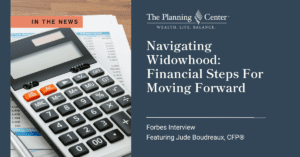By The Planning Center, Financial Planner
Ladies, who manages your household finances? My guess is it’s you.
 While many households share financial responsibility equally, in the majority of American households, women are paying the bills, balancing the checkbook, setting money aside for rainy days, and know where virtually every dollar goes. 1 Think about it: you are the CFO of your family. (How boss is that?! Nice going!)
While many households share financial responsibility equally, in the majority of American households, women are paying the bills, balancing the checkbook, setting money aside for rainy days, and know where virtually every dollar goes. 1 Think about it: you are the CFO of your family. (How boss is that?! Nice going!)
This Director of Household Finance position is often underappreciated and overlooked for the impressive feat that it is. You ladies know a lot about finance – and our society gives you very little credit for it. So first of all: You’re awesome and our households, communities, and families wouldn’t run without you. Thank you!
However, only a small percentage of women claim to have investing experience and confidence in their ability to manage their longer-term goals.2 I often hear my women clients say things like:
- “investing is too complicated,”
- “I just don’t understand it.”
- “investing scares me because I don’t know enough,”
- “I don’t need to know about investing because my partner takes care of it all.”
Here’s the danger with that kind of thinking: Women typically earn less than men3 and often live longer.4 This means we really need to be savvy about what we’re doing with our money, since it’s likely at some point (if not already) we’ll be solo calling the financial shots. It’s your money and your future. We can’t afford to avoid or be afraid of it.
Investing is no harder than balancing your checkbook
As the household CFO you’re already doing the hard stuff. There’s little difference between managing the day-to-day expenses of your household and managing your long-term investments for your future. Don’t be afraid of it – tackle it!
Here’s how to get started:
1. Collect statements for all of your investment accounts. This can include your 401k, 403b, 457, IRA, Roth IRA, Individual brokerage, Joint and Trust accounts, or annuity statements. Collect the most recent statement (most come quarterly, some monthly) for you and your partner. Find one folder in your file cabinet and keep these all together. Or, if you’re tech savvy, create a secured Dropbox, Sync, Google Drive, or OneDrive folder. Make sure this folder is password protected, and make sure you use “two-factor authentication” for your account. As new statements arrive, drop them in this folder so they’re always easy to find.
2.  Read your statements. Every statement should have your starting balance for that period, the ending balance, the investment return, and any fees you’ve paid. These statements will also list your asset allocation (see #4) and then go into further detail of which funds you’re invested in. The biggest thing here is to look for discrepancies from one statement to the next.
Read your statements. Every statement should have your starting balance for that period, the ending balance, the investment return, and any fees you’ve paid. These statements will also list your asset allocation (see #4) and then go into further detail of which funds you’re invested in. The biggest thing here is to look for discrepancies from one statement to the next.
- Are the values about the same?
- Are there extra fees listed?
- Are the balances increasing?
This is similar to reading your checking account statement. At a minimum, you should be able to say, “Yup, this is definitely my account – things look about the same as the last statement.”
3. Know what fees you’re paying. By law, fees must be disclosed to you; the Securities and Exchange Commission requires it. These will be listed on your statement as an advisory fee, custodian fee, set up/annual fee, etc. Fees may fluctuate as your overall account size changes, but they should be consistent.If you see an additional fee, or a huge increase, make sure you call and ask why. You would do the same if you saw in increase in fee on your credit card statement, right? So don’t be intimidated. The phone number will be listed on the statement – give them a call and ask what’s up.
4. Have a general understanding of asset allocation. “Asset allocation” may sound like a sophisticated concept, but you’ll be surprised how simple it is. Think of this common differentiation: how much do you have in your checking account vs. your savings account. Same idea. Only asset allocation applies to your investments: how much do you have in stocks vs. bonds and cash.
Generally, the amount in bonds/cash will be conservative and stable. This money may grow, but it will be slow and steady. The amount in stocks involves more risk. Stocks are in the market, which will go up and down. Stocks have huge potential for growth, but it is usually understood that there is a relationship between risk and return. Normally, you have to take higher risks to get a higher return. This relationship means that stocks can also decline. The percentage of your accounts in stock is always listed first: a 60/40 portfolio is allocated to 60% stocks and 40% bonds/cash.
 5. Know which funds you hold. This is arguably the hardest step. The investment world likes to make this step complicated, using code words and abbreviations for everything. A good financial planner will help you decode these abbreviations.
5. Know which funds you hold. This is arguably the hardest step. The investment world likes to make this step complicated, using code words and abbreviations for everything. A good financial planner will help you decode these abbreviations.
Knowing the funds in your accounts is like knowing the stores, as listed on your checking account/credit card statement, where you spent money. The name of each store (or fund) will be listed on every statement along with it’s current stock price, number of shares you own, and the total account value.
If you’re interested in knowing more about each of your funds (and who wouldn’t be, after all you are a part-owner in them!?!), you can use Google Finance or Morningstar online and type in the ticker symbol of each fund. There is more information on those two sites than you would probably ever want to know about your funds. Visit these sites and read up a little about each fund. The more you read the more you will understand – and bring your questions to your next planning meeting.
PAUSE!
You’re probably thinking: this woman is a financial planner and she’s telling me to manage my own investments?!! Isn’t that her job?
The answers are Yes and Yes. I want all my clients to have a baseline understanding of their investments so they know what they’re doing and how they’re invested. It is my job to make specific recommendations based on your life goals and to help you understand. This is similar to when you visit a doctor – the more you know about your specific needs, the better they can support you. Which brings me to my last point:
 6. Find a financial planner you trust. My motto is: “Ask until you understand. If you don’t understand, keep asking.” If the person you’re asking doesn’t give you a straight answer, keep looking until you find the person who will.
6. Find a financial planner you trust. My motto is: “Ask until you understand. If you don’t understand, keep asking.” If the person you’re asking doesn’t give you a straight answer, keep looking until you find the person who will.
Remember: it’s your future at stake. The right planner will be your partner and a trusted confidant. She (or he) will be interested in what matters in your life to help you dream bigger, achieve your goals, and work with you to make sure you understand what you’re doing and why you’re doing it.
Conclusion
Thank you for your hard work managing your household. I imagine it’s not your favorite part of your day, but the economy is thriving because of you. Understanding your investments will have the same impact. This task doesn’t have to be complicated. Start collecting your statements and get to it and find a professional to help you get started when you need extra support. You got this, CFO.
The advisors at The Planning Center can help you set a course for personal growth, financial strength, and most importantly, peace of mind. Give us a call at 888-333-6986. Email us at info@theplanningcenter.com






